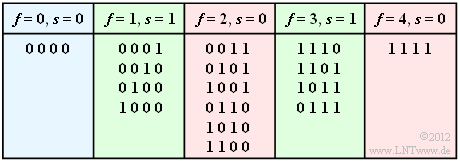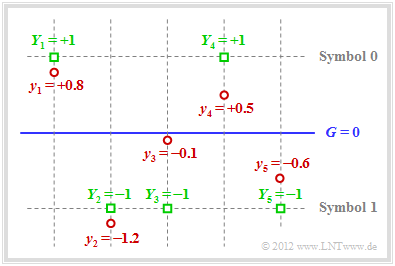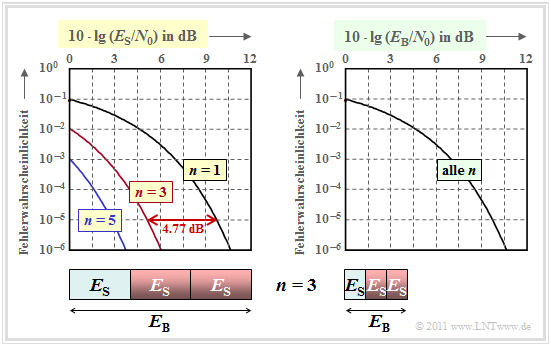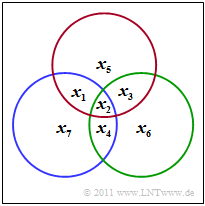Difference between revisions of "Channel Coding/Examples of Binary Block Codes"
| Line 9: | Line 9: | ||
<br> | <br> | ||
The '''Single parity-check code''' $\rm (SPC)$ adds to the information block $\underline{u}= (u_1, u_2, \hspace{0.05cm}\text{...}\hspace{0.05cm}, u_k)$ a parity bit $p$: | The '''Single parity-check code''' $\rm (SPC)$ adds to the information block $\underline{u}= (u_1, u_2, \hspace{0.05cm}\text{...}\hspace{0.05cm}, u_k)$ a parity bit $p$: | ||
| − | [[File:P ID2346 KC T 1 3 S1 v2.png|right|frame|Various single parity check codes $(n = k + 1)$|class=fit]] | + | [[File:P ID2346 KC T 1 3 S1 v2.png|right|frame|Various single parity-check codes $(n = k + 1)$|class=fit]] |
:$$\underline{u} = (u_1, u_2,\hspace{0.05cm} \text{...} \hspace{0.05cm} , u_k) \hspace{0.3cm}$$ | :$$\underline{u} = (u_1, u_2,\hspace{0.05cm} \text{...} \hspace{0.05cm} , u_k) \hspace{0.3cm}$$ | ||
:$$\Rightarrow \hspace{0.3cm} | :$$\Rightarrow \hspace{0.3cm} | ||
Revision as of 10:10, 13 June 2022
Single Parity-check Codes
The Single parity-check code $\rm (SPC)$ adds to the information block $\underline{u}= (u_1, u_2, \hspace{0.05cm}\text{...}\hspace{0.05cm}, u_k)$ a parity bit $p$:
- $$\underline{u} = (u_1, u_2,\hspace{0.05cm} \text{...} \hspace{0.05cm} , u_k) \hspace{0.3cm}$$
- $$\Rightarrow \hspace{0.3cm} \underline{x} = (x_1, x_2,\hspace{0.05cm}\text{...} \hspace{0.05cm} , x_n) = (u_1, u_2,\hspace{0.05cm} \text{...}\hspace{0.05cm} , u_k, p) \hspace{0.05cm}.$$
The graphic shows three coding examples:
- $|\hspace{0.05cm}\mathcal{C}\hspace{0.05cm}| = 4 \hspace{0.15cm} (k = 2)$,
- $|\hspace{0.05cm}\mathcal{C}\hspace{0.05cm}| = 8 \hspace{0.15cm} (k = 3)$,
- $|\hspace{0.05cm}\mathcal{C}\hspace{0.05cm}| = 16 \hspace{0.15cm} (k = 4)$.
This very simple code can be characterized as follows:
- From $n = k + 1$ follows for the code rate $R = k/n = (n-1)/n$ and for the redundancy $1-R = 1/n$. For $k = 2$, for example, the code rate is $2/3$ and the relative redundancy is $33.3\%$.
- The parity bit is obtained by modulo–2 addition. This is the addition in the Galois field to the base $2$ ⇒ $\rm GF(2)$, so that $1 \oplus 1 = 0$ results:
- \[p = u_1 \oplus u_2 \oplus \text{...} \hspace{0.05cm} \oplus u_k \hspace{0.05cm}.\]
- Thus every valid code word $\underline{x}$ contains an even number of ones. Expressed as $\oplus$ or in simplified notation according to the second equation, this condition reads:
- \[ x_1 \oplus x_2 \oplus \text{...} \hspace{0.05cm} \oplus x_n = 0 \hspace{0.05cm}, \hspace{0.5cm}{\rm or:}\hspace{0.5cm} \sum_{i=1}^{n} \hspace{0.2cm} x_i = 0\hspace{0.05cm} , \hspace{0.3cm} {\rm addition\hspace{0.15cm} in \hspace{0.15cm} GF(2)} \hspace{0.05cm}. \]
- For $k = 2$ ⇒ $n = 3$ the following four code words result, where the parity bit $p$ is marked by a small arrow in each case:
- \[\underline{x}_0 = (0, 0_{\hspace{0.05cm} \rightarrow}\hspace{0.05cm} 0)\hspace{0.05cm}, \hspace{0.2cm} \underline{x}_1 = (0, 1_{\hspace{0.05cm} \rightarrow}\hspace{0.05cm} 1)\hspace{0.05cm}, \hspace{0.2cm} \underline{x}_2 = (1, 0 _{\hspace{0.05cm} \rightarrow}\hspace{0.05cm} 1)\hspace{0.05cm}, \hspace{0.2cm} \underline{x}_3 = (1, 1 _{\hspace{0.05cm} \rightarrow}\hspace{0.05cm} 0)\hspace{0.05cm}.\]
- This code $\mathcal{C} = \big \{ (0, 0, 0), \ (0, 1, 1), \ (1, 0, 1), \ (1, 1, 0) \big \}$ is linear since the sum of any two code words again gives a valid codeword, for example:
- $$\underline{x}_1 \oplus \underline{x}_2 = \underline{x}_3.$$
- For any $k$ ⇒ $n = k+1$ each code word differs from all others at an even number of positions. Thus, the minimum distance of the code is
- $$d_{\rm min} = 2.$$
$\text{Definition:}$ Each $\text{single parity-check code (SPC)}$ can be formally described as follows:
- \[\mathcal{C} = \{ \underline{x} \in {\rm GF}(2^n)\hspace{-0.15cm}: \hspace{0.15cm}{\rm with \hspace{0.15cm}even\hspace{0.15cm} number\hspace{0.15cm} of\hspace{0.15cm} ones\hspace{0.15cm} in \hspace{0.15cm} } \underline{x} \}\hspace{0.05cm}.\]
- With the general code name $(n, \ k, \ d_{\rm min})$ any Single Parity–check Code can also be named $\text{SPC }(n, \ n-1, \ 2)$ .
- The top graph thus shows the $\text{SPC (3, 2, 2)}$, the $\text{SPC (4, 3, 2)}$, and the $\text{SPC (5, 4, 2)}$.
The digital channel may change the codeword $\underline{x}= (x_1, x_2, \hspace{0.05cm}\text{...}\hspace{0.05cm}, x_n)$ to the receive word $\underline{y}= (y_1, y_2, \hspace{0.05cm}\text{...}\hspace{0.05cm}, y_n)$. With the error vector $\underline{e}= (e_1, e_2, \hspace{0.05cm}\text{...}\hspace{0.05cm}, e_n)$ holds:
- $$\underline{y}= \underline{x} \oplus \underline{e}.$$
For decoding the Single Parity Check Code one forms the so-called syndrome:
- \[s = y_1 \oplus y_2 \oplus \hspace{0.05cm}\text{...} \hspace{0.05cm} \oplus y_n = \sum_{i=1}^{n} \hspace{0.2cm} y_i \hspace{0.1cm} \in \hspace{0.2cm} \{0, 1 \} \hspace{0.05cm}.\]
The result $s=1$ then indicates (at least) one bit error within the codeword, while $s=0$ should be interpreted as follows:
- The transmission was error-free, or:
- The number of bit errors is even.
$\text{Example 1:}$ We consider the $\text{SPC (4, 3, 2)}$ and assume that the null word was sent. The table shows all possibilities that $f$ bits are corrupted and gives the respective syndrome $s \in \{0, 1\}$ .
For the BSC model with the crossover probability (Noah) $\varepsilon = 1\%$ the following probabilities then result:
- The information word is correctly decoded (blue background):
- \[{\rm Pr}(\underline{v} = \underline{u}) = {\rm Pr}(\underline{y} = \underline{x}) = (1 - \varepsilon)^n = 0.99^4 \approx 96\,\%\hspace{0.05cm}.\]
- The decoder detects that transmission errors have occurred (green background):
- \[{\rm Pr}(s=1) \hspace{-0.1cm} = \hspace{-0.1cm} \sum_{f=1 \atop f \hspace{0.1cm}{\rm ungerade} }^{n} {n \choose f} \cdot \varepsilon^{f} \cdot (1 - \varepsilon)^{n-f} = {4 \choose 1} \cdot 0.01 \cdot 0.99^3 + {4 \choose 3} \cdot 0.01^3 \cdot 0.99 \approx 3.9\,\%\hspace{0.05cm}.\]
- The information word is decoded incorrectly (red background):
- \[{\rm Pr}(\underline{v} \ne \underline{u}) \hspace{-0.1cm} = \hspace{-0.1cm} \sum_{f=2 \atop f \hspace{0.1cm}{\rm gerade} }^{n} {n \choose f} \cdot \varepsilon^{f} \cdot (1 - \varepsilon)^{n-f} = 1 - {\rm Pr}(\underline{v} = \underline{u}) - {\rm Pr}(s=1)\approx 0.1\,\%\hspace{0.05cm}.\]
We refer here to the interactive applet Binomial and Poisson Distribution. The results obtained here are also discussed again in the Exercise A1.5
$\text{Example 2:}$ Error correction of the single parity–check code is not possible for the BSC–model unlike the BEC–channel (Binary Erasure Channel).
Bit errors are excluded with this one. If only one bit is erased $($ erasure, $\rm E)$, then due to the fact "the number of ones in the codeword is even" error correction is also possible, for example for the $\text{SPC (5, 4, 2)}$:
\[\underline{y} = (1, 0, {\rm E}, 1, 1) \hspace{0.2cm}\Rightarrow\hspace{0.2cm}\underline{z} = (1, 0, 1, 1, 1) \hspace{0.2cm}\Rightarrow\hspace{0.2cm} \underline{v} = (1, 0, 1, 1) = \underline{u}\hspace{0.05cm},\] \[\underline{y}=(0, 1, 1, {\rm E}, 0) \hspace{0.2cm}\Rightarrow\hspace{0.2cm}\underline{z} = (0, 1, 1, 0, 0) \hspace{0.2cm}\Rightarrow\hspace{0.2cm} \underline{v} = (0, 1, 1, 0) = \underline{u}\hspace{0.05cm},\] \[\underline{y} = (0, 1, 0, 1, {\rm E}) \hspace{0.2cm}\Rightarrow\hspace{0.2cm}\underline{z} = (0, 1, 0, 1, 0) \hspace{0.2cm}\Rightarrow\hspace{0.2cm} \underline{v} = (0, 1, 0, 1) = \underline{u}\hspace{0.05cm}.\]
$\text{Example 3:}$ Also with AWGN channel error correction is possible when applying Soft Decision . For the following we assume bipolar signaling:
- $x=0$ ⇒ $\tilde{x}= +1$, as well as
- $x=1$ ⇒ $\tilde{x}= -1$.
The graphic illustrates the facts presented here:
- For example, the receive vector is (red dots):
- \[\underline{y} = (+0.8, -1.2, -0.1, +0.5, -0.6) \hspace{0.05cm}.\]
- With a hard decision (threshold $G = 0$, only the signs are evaluated) one would arrive at the following binary result $($green squares $Y_i = y_i/ \vert y_i \vert)$:
- \[\underline{Y} = (+1, -1, -1, +1, -1) \hspace{0.05cm}.\]
- In symbol notation, this gives $(0, 1, 1, 0, 1)$, which is not a valid codeword of $\text{SPC (5, 4, 2)}$ ⇒ syndrome $s = 1$. So one, three or five bits must have been corrupted.
- The probability for three or five bit errors, however, is orders of magnitude smaller than that for a single error. The assumption of "one bit error" is therefore not unreasonable.
- Since the received value $y_3$ is very close to the threshold $G = 0$ it is assumed that exactly this bit has been corrupted.
- Thus, in Soft Decision, the decision is for $\underline{z} = (0, 1, 0, 0, 1)$ ⇒ $\underline{v} = (0, 1, 0, 0)$.
- The block error probability ${\rm Pr}(\underline{v} \ne \underline{u})$ is thus lowest.
Repetition Codes
$\text{Definition:}$ A $\text{repetition code}$ ($\rm RC)$ is a linear binary $(n, \, k)$–block code of the form
- \[\mathcal{C} = \big \{ \underline{x} \in {\rm GF}(2^n)\text{:} \ \ x_i = x_j \hspace{0.15cm}{\rm for \hspace{0.15cm}all\hspace{0.25cm} } i, j = 1, \hspace{0.05cm} \text{...} \hspace{0.05cm}, n \big \}.\]
- The code parameter $n$ denotes the code length. Independent of $n$ always holds $k = 1$.
- Accordingly, there exist only the two codewords $(0, 0, \hspace{0.05cm} \text{...} \hspace{0.05cm} , 0)$ and $(1, 1, \hspace{0.05cm}\text{...}\hspace{0.05cm} , 1)$, which differ in $n$ binary places.
- From this follows for the minimum distance $d_{\rm min} = n$.
The graphic shows repetition codes for
- $n=3$,
- $n=4$,
- $n=5$.
Such a repetition code has the following properties:
- This $(n, \, 1, \, n)$–block code has the very small code rate $R = 1/n$, so it is only suitable for transferring or storing small files.
- On the other hand, the repetition code is very robust.
- In particular, in the BEC channel (Binary Erasure Channel), a single correctly transmitted bit at any position (all other bits may be erased) is sufficient to correctly decode the information word.
$\text{Example 4: Decoding and error probabilities at the BSC channel.}$
The BSC channel with $\varepsilon = 10\%$ applies. The decoding is based on the majority principle.
- For odd $n$ , $e=n-1$ bit errors can be detected and $t=(n-1)/2$ bit errors can be corrected. This gives $u$ for the probability of correct decoding of the information bits :
- \[{\rm Pr}(v = u) = \sum_{f=0 }^{(n-1)/2} {n \choose f} \cdot \varepsilon^{f} \cdot (1 - \varepsilon)^{n-f} \hspace{0.05cm}.\]
- The following numerical values are valid for $n = 5$. That means: There are $t = 2$ Bit errors correctable:
- \[{\rm Pr}(v = u) = (1 - \varepsilon)^5 + 5 \cdot \varepsilon \cdot (1 - \varepsilon)^4 + 10 \cdot \varepsilon^2 \cdot (1 - \varepsilon)^3 \approx 99.15\,\%\]
- \[\Rightarrow\hspace{0.3cm}{\rm Pr}(v \ne u) = 1- {\rm Pr}(v = u) \approx 0.85\,\%\hspace{0.05cm}.\]
- On the other hand, with even $n$ only $t=n/2-1$ errors can be corrected. If $n$ is increased from $5$ to $6$, then only two bit errors within a codeword can be corrected. A third bit error cannot be corrected, but at least it can be recognized:
- \[{\rm Pr}({\rm not\hspace{0.15cm} correctable\hspace{0.15cm} error}) = {6 \choose 3} \cdot \varepsilon^{3} \cdot (1 - \varepsilon)^{3}= 20 \cdot 0.1^{3} \cdot 0.9^{3}\approx 1.46\,\%\hspace{0.05cm}. \]
- An (undetected) decoding error $(v \ne u)$ results only when four or more bits have been corrupted within the 6 bit–word. As an approximation, assuming that five or six bit errors are much less likely than four:
- \[{\rm Pr}(v \ne u) \approx {6 \choose 4} \cdot \varepsilon^{4} \cdot (1 - \varepsilon)^{2}= 0.122\,\%\hspace{0.05cm}.\]
- It is interesting to note that for $\text{RC(6, 1, 6)}$ the probability ${\rm Pr}(v = u)$ for a possible and correct decoding with $98.42\%$ is smaller than for $\text{RC (5, 1, 5)}$. For the latter:
- $${\rm Pr}(v = u) = 1- 0.00122 \approx 99.88\%.$$
$\text{Example 5: Performance of the repetition code at the AWGN channel.}$
We now consider the AWGN channel. For uncoded transmission $($or the repeat code with $n=1)$ the received value is $y = \tilde{x}+\eta$, where $\tilde{x} \in \{+1, -1\}$ denotes the information bit in bipolar signaling and $\eta$ denotes the noise term. To avoid confusion with the code parameter $n$ we have renamed the noise: $n → \eta$.
For the error probability, with the complementary Gaussian error integral ${\rm Q}(x)$
- \[{\rm Pr}(v \ne u) = {\rm Q}(\sqrt{\rho}) \hspace{0.05cm},\]
where the following physical quantities are to be used:
- the SNR $\rho= 1/\sigma^2 = 2 \cdot E_{\rm S}/N_0$,
- the energy $E_{\rm S}$ per code symbol ⇒ "symbol energy",
- the normalized standard deviation $\sigma$ of the noise, valid for the bipolar information bit $\tilde{x} \in \{+1, -1\}$, and
- The constant (one-sided) noise power density $N_0$ of the AWGN–noise.
In contrast, for a $(n, 1, n)$–repetition code, the input value of the maximum likelihood decoder $y \hspace{0.04cm}' = \tilde{x} \hspace{0.04cm}'+\eta \hspace{0.04cm}'$ with the following properties:
- \[\tilde{x} \hspace{0.04cm}' =\sum_{i=1 }^{n} \tilde{x}_i \in \{ +n, -n \}\hspace{0.2cm} \Rightarrow\hspace{0.2cm} n{\rm -fold \hspace{0.15cm}amplitude}\]
- \[\hspace{4.8cm} \Rightarrow\hspace{0.2cm}n^2{\rm -fold \hspace{0.15cm}power}\hspace{0.05cm},\]
- \[\eta\hspace{0.04cm}' = \sum_{i=1 }^{n} \eta_i\hspace{0.2cm} \Rightarrow\hspace{0.2cm} n{\rm -fold \hspace{0.15cm}variance:\hspace{0.15cm} } \sigma^2 \rightarrow n \cdot \sigma^2\hspace{0.05cm},\]
- \[\rho\hspace{0.04cm}' = \frac{n^2}{n \cdot \sigma^2} = n \cdot \rho \hspace{0.2cm} \Rightarrow\hspace{0.2cm}{\rm Pr}(v \ne u) = {\rm Q}(\sqrt{n \cdot \frac{2E_{\rm S} }{N_0} } )\hspace{0.05cm}.\]
The error probability in double logarithmic representation is shown in the left graph. As abscissa is $10 \cdot \lg \, (E_{\rm S}/N_0)$ plotted. The energy per bit $(E_{\rm B})$ is $n$ times larger than the symbol energy $E_{\rm S}$, as illustrated in the graph for $n=3$ .
This set of curves can be interpreted as follows:
- If one plots the error probability over the abscissa $10 \cdot \lg \, (E_{\rm S}/N_0)$ then $n$–times repetition over uncoded transmission $(n=1)$ results in a significant improvement.
- The curve for the repetition factor $n$ is obtained by left shifting by $10 \cdot \lg \, n$ (in dB) with respect to the comparison curve. The gain is $4.77 \ {\rm dB} \ (n = 3)$ or $\approx 5 \ {\rm dB} \ (n = 5)$.
- However, a comparison at constant $E_{\rm S}$ is not fair, since with the repetition code $\text{RC (5, 1, 5)}$ one spends a factor $n$ larger energy for the transmission of an information bit than with uncoded transmission: $E_{\rm B} = E_{\rm S}/{R} = n \cdot E_{\rm S}\hspace{0.05cm}.$
From the graph on the right, we can see that all the curves lie exactly on top of each other when plotted on the abscissa $10 \cdot \lg \, (E_{\rm B}/N_0)$
$\text{Conclusion regarding repeat codes on the AWGN channel:}$
- The probability of error is independent of the repetition factor for a fair comparison $n$: ${\rm Pr}(v \ne u) = {\rm Q}\left (\sqrt{2E_{\rm B} /{N_0} } \right ) \hspace{0.05cm}.$
- For the AWGN channel, no coding gain can be achieved by a repeat code.
Hamming Codes
Richard Wesley Hamming specified a class of binary block codes in 1962 that differ in the number $m = 2, 3, \text{...} $ of added parity bits . For this code class:
- The code length always results in $n = 2^m -1$. Consequently, only the lengths $n = 3$, $n = 7$, $n = 15$, $n = 31$, $n = 63$, $n = 127$, $n = 255$, etc. are possible for the Hamming code.
- An information word consists of $k = n-m$ bits. The code rate is therefore equal to
- \[R = \frac{k}{n} = \frac{2^m - 1 - m}{2^m - 1} \in \{1/3, \hspace{0.1cm}4/7,\hspace{0.1cm}11/15,\hspace{0.1cm}26/31,\hspace{0.1cm}57/63, \hspace{0.1cm}120/127,\hspace{0.1cm}247/255, \hspace{0.05cm} \text{...} \hspace{0.05cm} \}\hspace{0.05cm}.\]
- All Hamming codes have the minimum distance $d_{\rm min} = 3$ . With larger code length $n$ one reaches $d_{\rm min} = 3$ already with less redundancy, i.e. with larger code rate $R$.
- From the statement $d_{\rm min} = 3$ it further follows that here $e = d_{\rm min} -1 =2$ errors can be detected and one can $t = (d_{\rm min} -1)/2 = 1$ correct errors.
- The Hamming code $\text{HC (3, 1, 3)}$ is identical to the repeat code $\text{RP (3, 1, 3)}$ and is:
- \[\mathcal{C} = \big \{ (0, 0, 0) \hspace{0.05cm}, (1, 1, 1) \big \}\hspace{0.05cm}. \]
- In systematic coding, the first $k$ digits of each Hamming codeword $\underline{x}$ are identical to the information word $\underline{u}$. This is then followed by the $m = n-k$ parity bit:
- \[\underline{x} = ( x_1, x_2,\hspace{0.05cm}\text{...} \hspace{0.05cm}, x_n) = ( u_1, u_2, \hspace{0.05cm}\text{...} \hspace{0.05cm}, u_k, p_1, p_2, \hspace{0.05cm}\text{...} \hspace{0.05cm}, p_{n-k}) \hspace{0.05cm}.\]
$\text{Example 6: Parity equations of the (7, 4, 3) Hamming code}$
The $\text{(7, 4, 3)}$–Hamming code is illustrated by the diagram shown. From it one can derive the three conditions:
- \[x_1 \oplus x_2 \oplus x_3 \oplus x_5 \hspace{-0.1cm} = \hspace{-0.1cm} 0 \hspace{0.05cm},\]
- \[x_2 \oplus x_3 \oplus x_4 \oplus x_6 \hspace{-0.1cm} = \hspace{-0.1cm} 0 \hspace{0.05cm},\]
- \[x_1 \oplus x_2 \oplus x_4 \oplus x_7 \hspace{-0.1cm} = \hspace{-0.1cm} 0 \hspace{0.05cm}. \]
- In the diagram, the red circle indicates the first test equation, the green the second and the blue the last.
- In each circle, the number of ones must be even.
In systematic coding of the $\text{(7, 4, 3)}$ Hamming code
- \[x_1 = u_1 ,\hspace{0.2cm} x_2 = u_2 ,\hspace{0.2cm} x_3 = u_3 ,\hspace{0.2cm} x_4 = u_4 ,\hspace{0.2cm} x_5 = p_1 ,\hspace{0.2cm} x_6 = p_2 ,\hspace{0.2cm} x_7 = p_3 \]
are the equations of determination of the three test bits, as shown in the diagram:
- \[p_1 =u_1 \oplus u_2 \oplus u_3 \hspace{0.05cm},\]
- \[p_2 = u_2 \oplus u_3 \oplus u_4 \hspace{0.05cm},\]
- \[p_3 = u_1 \oplus u_2 \oplus u_4 \hspace{0.05cm}.\]
The table shows the $2^k = 16$ allowed codewords of the systematic $\text{(7, 4, 3)}$ codes:
- $$\underline{x} = ( x_1, x_2, x_3, x_4, x_5, x_6, x_7) = ( u_1, u_2, u_3, u_4, p_1, p_2, p_3).$$
- The information word $\underline{u} =( u_1, u_2, u_3, u_4)$ is shown in black and the check bits $p_1$, $p_2$ and $p_3$ in red.
- It can be seen from this table that each two of the $16$ possible codewords differ in at least $d_{\rm min} = 3$ binary values.
Later the Decoding of linear block codes will be covered in more detail. The following example is intended to explain the decoding of the Hamming code rather intuitively.
$\text{Example 7: Parity equations of the (7, 4, 3) Hamming code}$
We further assume the systematic $\text{(7, 4, 3)}$ code and consider the receiving word $\underline{y} = ( y_1, y_2, y_3, y_4, y_5, y_6, y_7)$. For decoding, we form the three parity equations
- \[ y_1 \oplus y_2 \oplus y_3 \oplus y_5 \hspace{-0.1cm}= \hspace{-0.1cm} 0 \hspace{0.05cm},\hspace{0.5cm}{\rm (I)} \]
- \[y_2 \oplus y_3 \oplus y_4 \oplus y_6 \hspace{-0.1cm}= \hspace{-0.1cm}0 \hspace{0.05cm},\hspace{0.5cm}{\rm (II)} \]
- \[y_1 \oplus y_2 \oplus y_4 \oplus y_7 \hspace{-0.1cm}= \hspace{-0.1cm} 0\hspace{0.05cm}. \hspace{0.5cm}{\rm (III)}\]
Provided that at most one bit is corrupted in each codeword, the following statements are then valid. In the following $\underline{v}$ denotes the decoding result; this should always match $\underline{u} = (1, 0, 1, 0)$ :
- The receive word $\underline{y} = (1, 0, 1, 0, 1, 1)$ satisfies all three parity equations. This means that not a single transmission error has occurred ⇒ $\underline{y} = \underline{x}$ ⇒ $\underline{v} = \underline{u} = (1, 0, 1, 0)$.
- If two of the three parity equations are satisfied, such as for the received word $\underline{y} =(1, 0, 1, 0, 0, 1, 0)$, then one parity bit has been corrupted and the following also applies here $\underline{v} = \underline{u} = (1, 0, 1, 0)$.
- With $\underline{y} = (1, 0, 1, 1, 0, 1, 1)$ only the equation $\rm (I)$ is satisfied and the other two are not. Thus, the corruption of the fourth binary symbol can be corrected, and it is also valid here $\underline{v} = \underline{u} = (1, 0, 1, 0)$.
- A transmission error of the second bit ⇒ $\underline{y} = (1, 1, 1, 0, 0, 1, 1)$ leads to the fact that all three parity equations are not fulfilled. This error can also be clearly corrected since only $u_2$ occurs in all equations
.
Exercises for the chapter
Exercise 1.5: SPC (5, 4) and BEC Model
Exercise 1.5Z: SPC (5, 4) vs. RC (5, 1)
Exercise 1.6: (7, 4) Hamming Code






